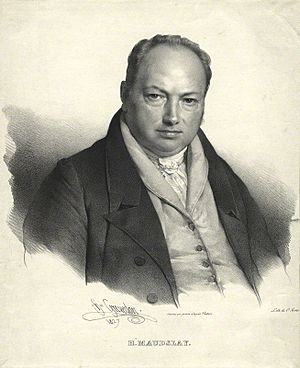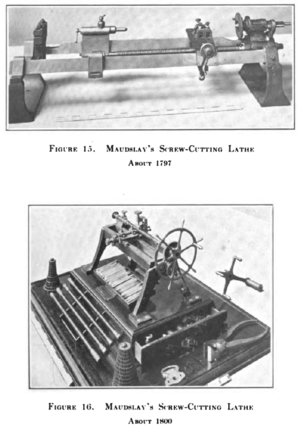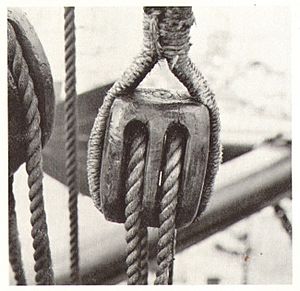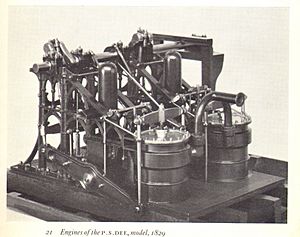Henry Maudslay facts for kids
Quick facts for kids
Henry Maudslay
|
|
|---|---|

Portrait by Pierre Louis ('Henri') Grevedon 1827
|
|
| Born | 22 August 1771 |
| Died | 14 February 1831 (aged 59) Lambeth, London, England
|
| Nationality | English |
| Occupation | Engineer |
| Engineering career | |
| Significant advance | Machine tool technology |
Henry Maudslay (born August 22, 1771 – died February 14, 1831) was a brilliant English inventor and engineer. He created amazing machine tools that helped build other machines. Many people see him as a key person in the start of modern machine technology. His ideas were super important for the Industrial Revolution, a time when factories and machines changed the world.
Around 1800, Maudslay invented a special screw-cutting lathe that could cut metal screws very precisely. This meant that all screws could be made the same size. This was a huge step! It allowed for interchangeable parts, meaning if one part broke, you could easily replace it with another identical one. This idea was vital for mass production, where many identical items are made quickly.
Contents
Henry Maudslay's Early Life
Henry Maudslay was born in Woolwich, England, in 1771. He was one of seven children. His father worked for the Royal Engineers at the Royal Arsenal in Woolwich.
When Henry was just 12 years old, he started working at the Arsenal. He began as a "powder monkey," filling cartridges with gunpowder. After two years, he moved to a carpenter's shop. Then, at age 15, he started training as a blacksmith. He became very skilled at making complex metal parts.
Maudslay's Engineering Career
Henry Maudslay quickly became known for his talent. When he was 18, a famous inventor named Joseph Bramah heard about him. Bramah hired Henry to work in his workshop.
Working with Joseph Bramah
Maudslay worked for Joseph Bramah in London. He helped Bramah solve some tough engineering problems.
The Bramah Lock
Joseph Bramah had invented a very secure lock. It was so strong that he offered a reward to anyone who could pick it. No one managed to open it for 47 years!
Maudslay designed special tools and machines to help make these complex locks. His work made it possible to produce the locks at a reasonable cost.
The Hydraulic Press
Bramah also designed a hydraulic press, a machine that uses liquid pressure to create a lot of force. But he had trouble making it work properly because the seals leaked.
Maudslay came up with a brilliant idea: a leather cup washer. This washer created a perfect seal, stopping the leaks. It also allowed the press to move easily when the pressure was released. Thanks to Maudslay's idea, the hydraulic press worked perfectly.
Inventing the Screw-Cutting Lathe
One of Maudslay's most important inventions was the first practical screw-cutting lathe in 1800. This machine changed how screws were made forever.
Before Maudslay, making screws was very difficult. Workers had to cut them by hand, which meant every screw was slightly different. This made it hard to replace parts.
Maudslay's lathe had a special tool holder that moved precisely. It used gears to control how the cutting tool moved. This allowed him to cut perfect, identical screw threads. He also created tools called taps and dies to make matching nuts and bolts.
This invention was revolutionary! It meant that any bolt of a certain size would fit any nut of the same size. This was a huge step towards making interchangeable parts possible, which is key for mass production.
Maudslay's original screw-cutting lathe can still be seen at the Science Museum in London.
Starting His Own Business
Maudslay was so good at his job that he became the manager of Bramah's workshop at just 19 years old.
In 1797, after eight years, Maudslay wanted a higher wage. When Bramah refused, Maudslay decided to start his own company. In 1798, he opened a small shop. By 1800, he moved to a larger place.
By 1810, Maudslay's business was growing fast. He had 80 workers and needed even more space. He moved to a bigger workshop in Lambeth. He also brought in a talented young engineer named Joshua Field as a partner. The company later became Maudslay, Sons and Field when Henry's sons joined.
Block-Making Machines
One of Maudslay's first big projects was for the British Navy. He built 42 special machines to make wooden rigging blocks for ships. Ships needed thousands of these blocks.
These machines were installed at the Portsmouth Block Mills. They could make 130,000 blocks a year! Only ten unskilled workers were needed to operate them, compared to 110 skilled workers before. This was one of the first times specialized machines were used in an assembly-line factory.
The Micrometer
Maudslay also invented the first bench micrometer. This amazing tool could measure tiny distances, down to one ten-thousandth of an inch. He called it the "Lord Chancellor" because it was used to settle any arguments about how accurate a part was.
Marine Engines
Maudslay's company became famous for building marine steam engines for ships. These engines were designed to fit into the small spaces on steamships.
His first marine engine was built in 1815 for a ship called the Richmond. In 1823, a Maudslay engine powered the Lightning, the first steam-powered ship for the Royal Navy. By 1829, his company built the largest marine engine of its time, a 400-horsepower engine for HMS Dee.
Henry's third son, Joseph Maudslay, continued to develop the marine engine business. In 1838, after Henry's death, the company built a powerful 750-horsepower engine for Isambard Kingdom Brunel's SS Great Western. This was the first ship built specifically to cross the Atlantic Ocean using steam power.
Maudslay's company also helped introduce some of the first screw propellers for ships. By 1850, they had supplied steam engines for over 200 vessels.
The Thames Tunnel
In 1825, Marc Isambard Brunel (father of Isambard Kingdom Brunel) started building the Thames Tunnel. This was a huge project to create the first tunnel under the River Thames in London.
The tunnel was very difficult to build. It would not have been possible without a special tunneling shield designed by Marc Brunel. Maudslay's company built this important shield. They also supplied powerful steam-driven pumps to keep the tunnel dry during construction. The tunnel was finally completed in 1842.
Henry Maudslay's Personal Life
In 1791, Henry Maudslay married Sarah Tindel. They had a daughter and four sons. Two of his sons, Thomas Henry and Joseph, later joined him in his business. Another son, William, became a civil engineer and helped start the Institution of Civil Engineers.
Later Life and Legacy
Towards the end of his life, Maudslay became very interested in astronomy. He started building a telescope and planned to build his own observatory.
In January 1831, he caught a cold while traveling from France. He was sick for four weeks and passed away on February 14, 1831. He was buried in the churchyard of St Mary Magdalen Woolwich.
Henry Maudslay's work laid a crucial foundation for the Industrial Revolution. His most important invention, the screw-cutting lathe, made it possible to create uniform screws and interchangeable parts. This was a revolutionary step needed for mass production and modern manufacturing.
Many famous engineers learned their skills in Maudslay's workshop. These included Richard Roberts, David Napier, Joseph Clement, Sir Joseph Whitworth, and James Nasmyth (who invented the steam hammer). Maudslay played a huge role in developing mechanical engineering when it was just beginning. He was especially a pioneer in creating the machine tools used in workshops all over the world.
Maudslay's company was one of Britain's most important engineering factories in the 1800s. It finally closed in 1904. Many of the tools he made are now part of the collection at the Science Museum, London.
See also
 In Spanish: Henry Maudslay para niños
In Spanish: Henry Maudslay para niños





